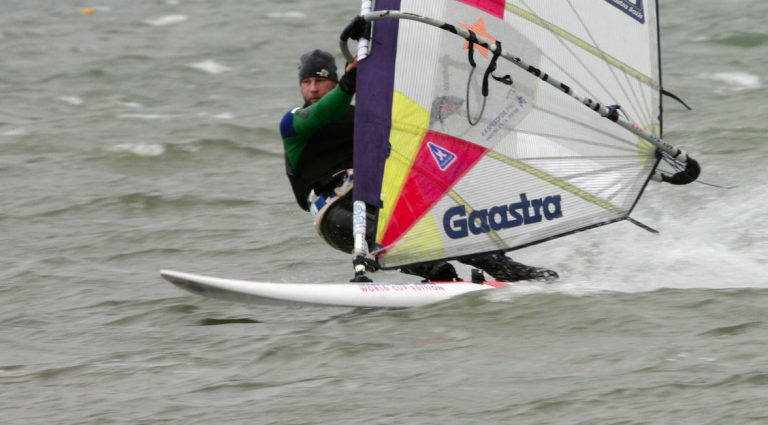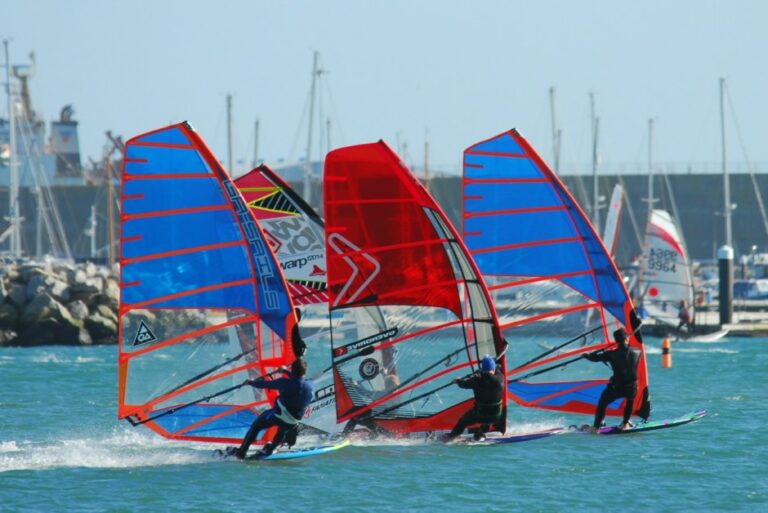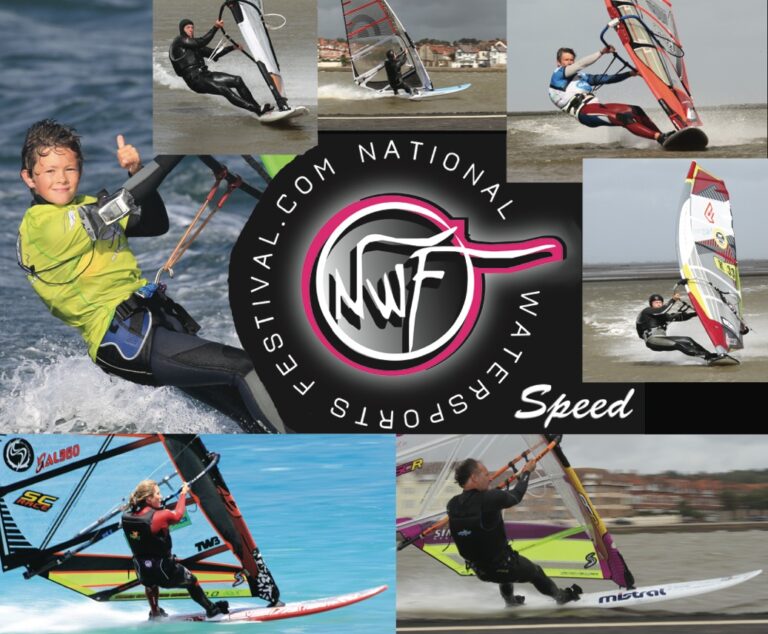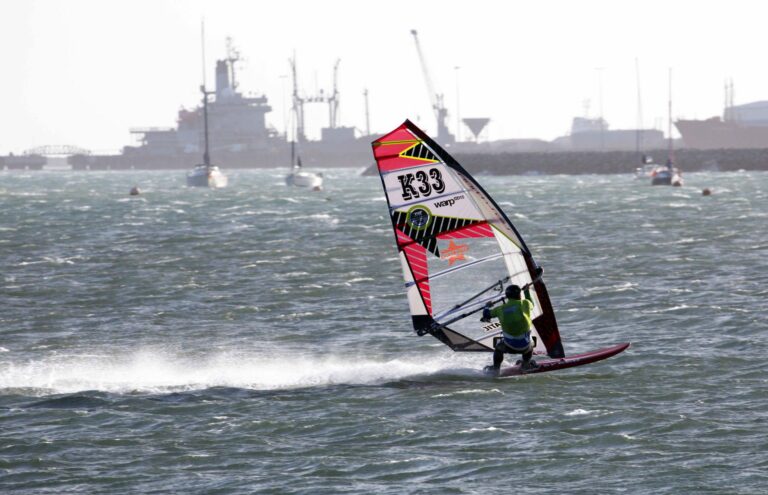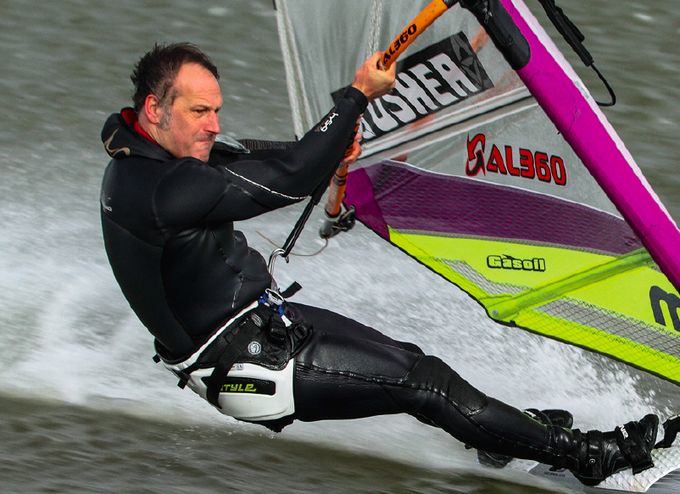If wavesailing is an art, then speedsailing must surely be considered a science. Oisín van Gelderen joins BOARDS to take a look at the need for speed with some of the absolute legends of the discipline – all record holders in their own right – and puts some questions to them about where we can go in the future.
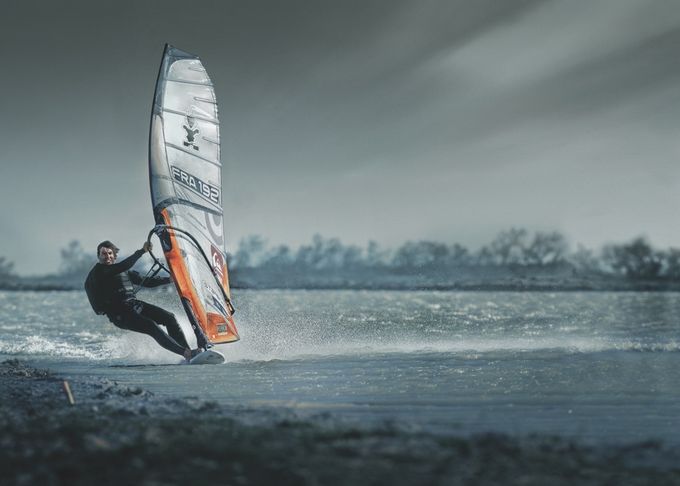
There is no doubt that it’s much harder to find a record-breaking speed day than it is to get perfect wavesailing. When it’s onshore: you jump more. Cross-offshore: you waveride. Either way you are happy, and can do this in a huge range of wind conditions and on different sized gear.
It’s true to say, of course, that speedsailing is actually our sport in its purest and simplest form – you just sheet in and blast no matter what the conditions. The sensation of speed is one of the very first things that got us all hooked; when even doing five knots on the local puddle for the first time felt like 50. This freedom to do it anywhere you can find wind and water is the basis of what we all love about windsurfing.
However, if it’s speedsailing Nirvana you are looking for – the conditions to break 40 knots (or even 50) – no other form of windsurfing relies so much on the planets to align perfectly, with all the variables falling into place for that magic record breaking session.
To go mega-quick, you will need the ideal wind strength (usually in excess of 35 knots) blowing at the perfect angle (140 degrees off the wind) over mirror flat water – which may be effected by current or only visible at low tide for a few hours, no matter what time of the day. A few knots too little wind, or a few degrees off – and forget it, you won’t break your PB or have any chance of a record.
The constant desire to improve the numbers on the GPS display becomes addictive, and at times can be expensive – burning diesel or jet fuel to find the perfect day. And even then, if you do manage to get all the elements aligned, there is the factor of having your kit completely dialled. And, of course, the fact that you need to switch off your brain to sail at 50+mph. Fear = slow. Hesitation = crashes. As Fred Haywood once said:
“If in doubt, don’t sheet out!”
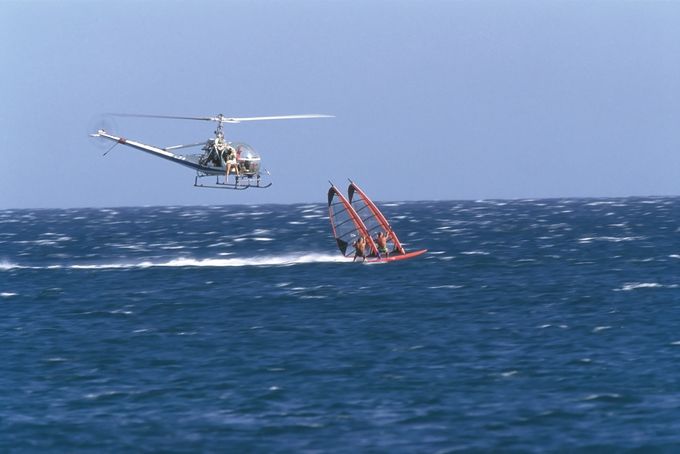
Currently, Luderitz is the pinnacle of this dedication to chase the limits of our sport. A narrow manmade ditch dug into a sandy lagoon, at the perfect angle, in one of the windiest places in the world. All this to get the conditions part sorted. It’s the speedsailing equivalent of Ho’okipa; the proving ground where the only thing to hold you back is your own ability.
Naturally, all of our Champions have been there, done that, worn the t-shirt, got the record. Yet they all still want to come back for more. There is unfinished business. There are personal goals to beat. Everyone wants to chase the 50 knots barrier (over 500 m). And all the while, the kiters are getting quicker.
So is it possible to catch the kites, or even to enter the heady realm of 60 knots and challenge for the Outright World Record again? Who better to discuss the finer points of speed with than: Antoine Albeau (Windsurfing World Record Holder and previous World Sailing Speed Record Holder), Zara Davis (Women’s Windsurfing World Record Holder), Bjorn Dunkerbeck (Nautical Mile Windsurfing Record Holder), Farrel O’Shea (UK Record Holder) and Erik Beale (the first sailor to break 40 knots and previous World Sailing Speed Record Holder).
Before we discuss how fast we can go, let’s look back to the early days…
Where did it all start?
The inaugural Weymouth Speed Week was held in 1972, and was the first event of its kind to accurately measure how fast a sailing vessel could go over 500 metres; the default measurement for all World Sailing Speed Records since the beginning. In ’72, Crossbow, a multihull proa skippered by Tim Coleman set the first official record at 26.3 knots, and dominated the World Record for a further fourteen years, pushing it as far as 36 knots by 1980.
Windsurfers first appeared at Weymouth in 1977, and reached the heady speed of 19.1 knots (without straps or a harness!). By the early ‘80s, windsurfing was booming and the chase for speed was well and truly underway. The likes of French Baron Arnaud De Rosnay, and his young wife Jenna were regulars at Weymouth, and Jenna held the outright Women’s Sailing World Record several times.
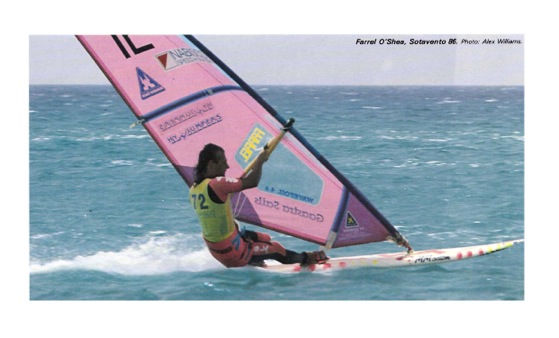
Breaking 30.
By ‘83, equipment development was at a pace similar to the speeds being achieved. Fred Haywood became the first windsurfer to break the 30 knot barrier, with massive backup from Hawaii, including a custom carbon wing for a mast – the first ever seen.
But it wasn’t until 1986 that Pascal Maka ended the domination of Crossbow, and finally gave the windsurfers the Outright World Sailing Speed Record – pushing the barrier to 38.86 knots on the now famous Sotavento Beach in Fuerteventura. At the same event Bjorn’s sister, Britt, became the first woman to break 30 knots hitting 33.77 knots, while three other sailors also beat Crossbow’s 36 knots World record that year; Jimmy Lewis, Erik Beale and Fred Haywood. The race was well and truly on!
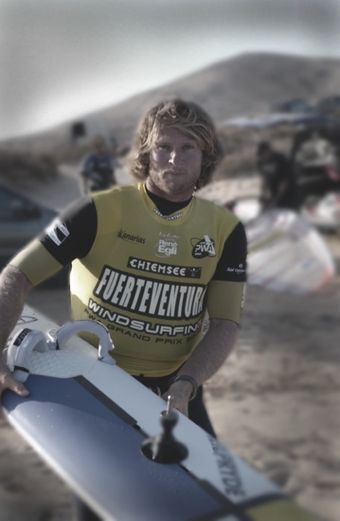
Breaking 40.
It became clear that stronger winds combined with flatter water was going to be the key to pushing the barriers of speed, so the following year in the south of France, the Camargue Windsurfing Club finished construction of ‘Le Trench’, an 800 m long canal at St. Maries De La Mer – designed specifically to take advantage of the strong Mistral winds.
In 1988, Erik Beale (a relative lightweight at 75 kg) rode his 27.5 cm wide Jimmy Lewis Mudshark with a custom 4.3 m down the trench to smash the 40 knot barrier with 40.48 knots. The trench was a success and windsurfers once again claimed a speedsailing milestone.
The battle continued with Maka at St.Maries, who took back the record two years later, only to then be overshadowed by Theirry Bielak in ’91, who beat Maka and continued to push the World Record as far as 45.34 knots by 1993. The Women’s World record was another all French battle at St. Maries between Babeth Coquelle and Brigitte Giminez, who traded records right up to ‘93 when Coquelle became the first woman to break 40 with a speed of 40.05 knots.
Yellow Pages.
While the windsurfers were having fun in France, the yachting world had not given up on the chase. On the other side of the world at Sandy Point in Australia, Yellow Pages Endeavour (another asymmetric trimaran) snatched back the World Record in 1993, when in only twenty knots of wind; it achieved a run of 46.52 knots – a record it would hold for eleven years.
It took a huge effort by Irish-Caribbean sailor Finian Maynard to resurrect windsurfing’s honour, when in 2004 his perseverance at St. Maries paid off and he took back the World Record by the tiniest of margins. It wasn’t until the following year though that things got really interesting, and he set another World Record at 48.7 knots. For the first time ever 50 knots seemed like a real possibility! Karin Jaggi also upped the women’s record to 41.25 at this event, breaking the twelve-year record of Coquelle.
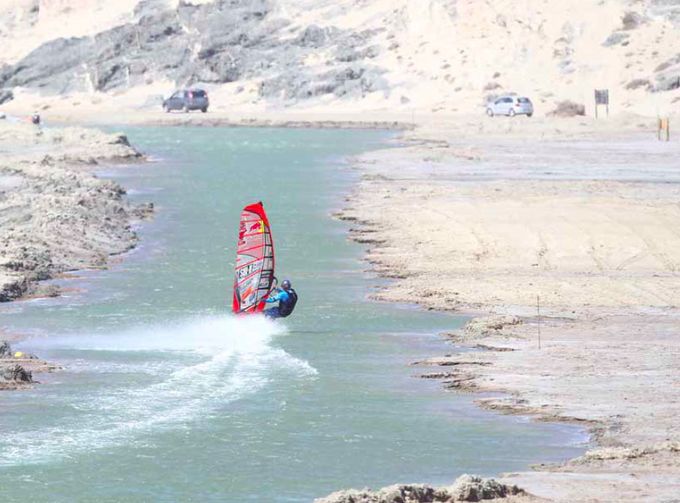
50 is the new 40.
By now the hunt for 50 was well underway, and thanks to equipment getting better, and the introduction of GPS units to accurately track speeds – speedsailing was gaining more momentum in the sport in general. In 2007, Dutch sailor Martin van Meurs (founder of gps-speedsurfing.com) was the first sailor ever to record over 50 knots peak speed on GPS during Dave White’s Driven by Wind event at Southend.
In 2008 Antoine Albeau made his own WR campaign at St. Maries, getting tantalisingly close with 49.08 knots. He got the 500 m World Record, but it looked under threat by a 50 ft hydrofoiling trimaran Hydroptere, that had been quickly improving its performance to almost 47 knots in much less wind.
However, 2008 also saw the kites really get their act together. Robbie Douglas (USA) was the first kitesurfer to claim the Sailing Speed World Record with 49.84 knots at a new spot in Luderitz, Namibia (currently too shallow for windsurfers). He upped his speed to over 50 knots, only to be eclipsed again by two Frenchmen, Sebastien Cattelan (50.26 knots), and then Alex Caizergues (50.57 knots).
The following year, Hydroptere snatched the record for the first time, before the three speedkiters each took a turn again in 2010, with Robbie Douglas eventually pushing the barrier up to 55.65 knots. Another French kiter, Charlotte Consorti became the first woman to sail over 50 knots with a run of 50.43 knots.
Vive la windsurfer!
All was not lost for us windsurfers however. In 2012 Luderitz course was moved 350 metres inland and the course finally adjusted to accommodate windsurfers. Anders Bringdal was the first to take advantage of the new course and became the first windsurfer to average 50 knots over 500 m.
Of course, Antoine Albeau was never far behind and snatched the Windsurfing World Record back for the second time in his career with a staggering 52.05 knots. Zara Davis also pushed the women’s record to dizzying heights with 45.83 knots, chased closely by Lena Erdil with 45.74 knots. Luderitz certainly delivered, and hopes were high for even better things to come.
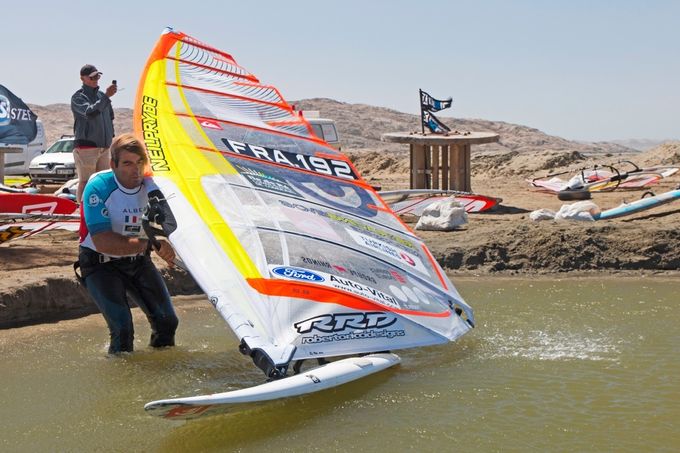
60 knots – to infinity and beyond!
But just when the kites thought they were going to have it all their own way – at the same time, 750km up the coast of Namibia, another mad Aussie in a trimaran was taking the record to a whole new level. Paul Larsen, in Vestas Sailrocket II (another ‘Proa’), blew us all out of the water. Over the course of a week, Vestas got 59.23 knots, 59.37 knots, and finally 64.45 knots (with a peak of 68 knots!), all in around 27 knots of wind!
Where are we now?
Compared to twenty-five years ago, modern equipment is user-friendlier. Shorter wider boards give more control (particularly in chop), while asymmetric fins can take much more load and rarely spin out. Sails have more twist and stability – with a much wider wind range.
There is no question that these improvements have benefitted every level of our sport, and every discipline. Lighter more efficient equipment makes for easier windsurfing for everyone, and more controllable gear means we are all progressing and sailing faster than ever.
This is highlighted best when looking online at the worldwide GPS speed rankings; where just over 200 people have recorded a 500m speed in excess of 40 knots, 145 have peaked over 45 knots, 22 over 50 knots (all but three of the latter were at Luderitz).
Five people have averaged over 51 knots, including Antoine and Bjorn, who along with Farrel, tip the scales at around 100 kg. So is it still fair to say that heaviest = fastest, with the heaviest guy being able to hold the biggest sail, or is it more about equipment or technique?
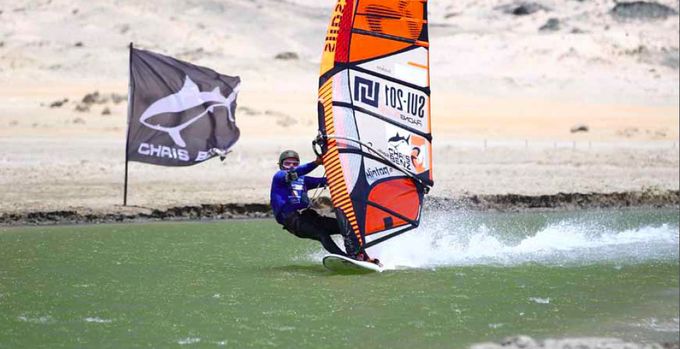
Erik: “Heavy dudes are faster – no question. It’s been a big problem for me my whole career. I am currently 80 kg and looking at leading up to 25 kg this year for a racing weight of 105 kg!”
Farrel: “Right now I’d say the equipment and its tuning is 90% of the game. Conditions also play a vital role. When the conditions yield; they yield for all. Sailor weight and strength are nothing without technique; it’s not always the size of the sail – but the ability to feel the wind – when very refined sheeting techniques come in to play.”
Antoine: “I see a lot of big heavy guys doing speed much more than me, yet they never went faster than me. This is an extreme sport, to go 100 km/h on the water you need to be able to do it and control it and be strong enough if you fall. So yes, the faster we go the fewer riders are there, this is normal. Only a few can go over my speed record, and even less can go over 55 knots.”
Bjorn: “Of course it’s a combination of all these things that is helping us to sail faster. I am 106 kg, which is also a reason why a 9.5 m and 130 litre board are no fun for me in gusty conditions!”
Needless to say, these guys are at the top end of pushing the barriers of speed, but it’s not only big guys who can go fast. It goes without saying that Zara is not 100 kg, so does she need to adopt a different approach to achieve a similar speed (relative to her weight)?
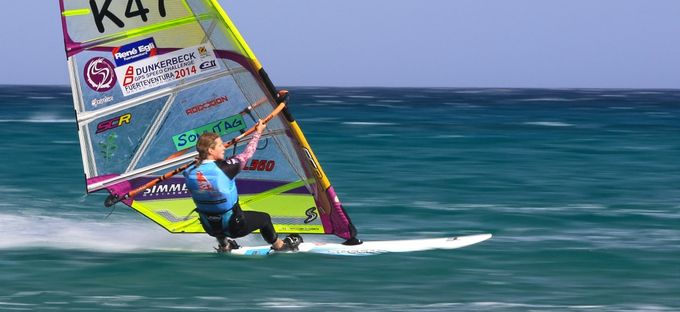
Zara: “Yes very much so, I work with my sponsors to develop equipment that works for me (not necessarily for a woman but for my weight and sailing style). Most of the top end development is done with big powerful guys, which doesn’t work for me as the bend characteristics and loads applied are all too high. For example, on the day I broke the women’s and Antoine the men’s world record in 2012, I was on the same size sail as Antoine was – but set up very differently.
Technique-wise we all have our own personal styles – not necessarily male/female biased – but more about using our body geometries to best advantage. Sailors’ skill level is also very important particularly at sites like Luderitz. Knowing the course and when to dig deep and when to glide (depending on the wind) is a real skill.”
Where can we go?
With speeds not increasing much since 2012, the question still remains – can we catch up with the kites, and will we ever have a shot at getting it back? The man with the biggest chance points out we will need to make a marked change:
Antoine: “I think it is going to be hard. SailRocket went 10 knots faster than everyone, but for me this is good, because for so long we have not moved much from 50 knots. Paul showed that it is possible to go 60 knots and more. Therefore, I think we need to go on foil, and really work on it, and I think we will also go faster.”
All agree that foils may be the future to reap the biggest rewards, and one to always think outside the box, Erik Beale, has already invested considerable time looking at different approaches to equipment. He revealed his latest designs at Luderitz in 2014:
Erik: “The Speedski concept is for a shallow water speed board. The WSSRC rules state that the min water depth is half the board width plus the fin depth. The Speedski is 34 cm wide with 10 to 14 cm fin. Therefore, it would be legal to run in 35 – 40 cm of water. On a really broad reach, we have the problem of the running chop forming at course angles below 130 degrees. A very shallow speed course would not allow large chop to form. So this design is to address this problem.”
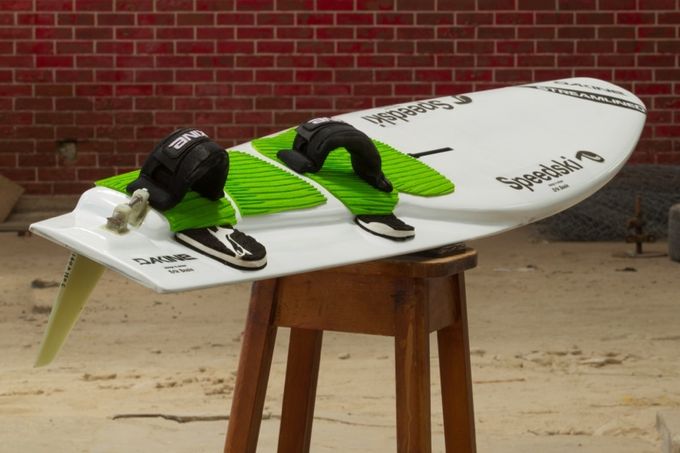
While the board needed more time for testing at Luderitz, Erik’s fin design in particular raised much interest from the other sailors:
Erik: “This technology was pioneered by SailRocket to break the 60 knot barrier. Paul Larsen was kind enough to share the basic concept with me. The fin uses the high-pressure side of the foil to generate most of the side force or lift which is the opposite of a regular NACA foil. There is an attached air cavity, which forms the trailing edge of the foil in the same way as a supercavitating foil, with the exception that the cavity does not propagate over the low-pressure side. I tested many prototypes over the course of last year to get it to work on a windsurf board.”
Farrel: “I love the fin programme Erik is working on. Like everything, it is early doors, and I’m not sure I want to be the bloke testing it at 50 knots. I’m not sure he wants to be that bloke either though!”
While Erik’s board may be the first step towards future board design, currently our speed is limited by how much power we can control. More wind is not necessarily the best option, as water conditions are too choppy at the nuclear end of scale, and an increase in sail power also requires an increase in leverage / weight to control it. But somehow we have to find a more efficient way to generate power in lighter winds, while drastically reducing drag.
Antoine: “If we want to progress in speed, we really need to work on going 50 knots in 30 knots of wind.”
Perhaps, like SailRocket, a wing sail hybrid concept will be the future for World Records?
Improve the course?
Clearly it will take time, and a lot of money to come up with a marked improvement to current equipment design, but in the meantime, could the course itself be improved? The Luderitz course (or “particle accelerator” as Erik calls it) is currently the best option, but it was designed for kitesurfers, who accelerate much faster and are already at full speed when they enter the 500 m run. Windsurfers are still accelerating 200 m into the run, and all our sailors noted that an evolution of the Luderitz design with a longer run-in and longer stopping area would give us more of a chance. Rumours are also flying around about possible courses being planned in France, Holland, Germany and Australia, though nothing has materialised as of yet, so credit where it is due to the Luderitz team for giving us the best speeds we have ever seen.
Dare to dream…
In the last 25 years, we have gone from 40 to 50 knots, (a 25% increase). Is another 25% a realistic target for the next 25 years, (meaning 63 knots in 2040), and where will we be in 10 years?
Farrel: “I don’t see why not. Other sailing disciplines have learnt a lot about hydrofoil technology for example. I’m not suggesting that’s the answer, yet the analogy of financial investment and results is always fitting. If research budget is available, I would suggest there are enough professor pie heads to take a windsurfer to 60 knots in say 10 years.”
Erik: “I do not see why we could do 70 knots one day with the right speed course. After reaching 49.5 knots Vmax at Luderitz, I’m still making my mind up if I really want to go faster. If I do, it’s to break 50 knots / 500m for sure!”
Bjorn: “If we can find a way for foils to work on a windsurfer, anything is possible! My immediate goal is 100km/h for 500m, and looking for partners and locations to develop my GPS Speed Challenge events.”
Zara: “My goal is still to take the outright women’s 500 m record, which currently stands at 50.45 knots. For the men in 10 years with the drive that is currently going on, I think they will be pushing the Sailrocket record of 65.45 knots. But who is to say where the kites and boat records will be then?”

